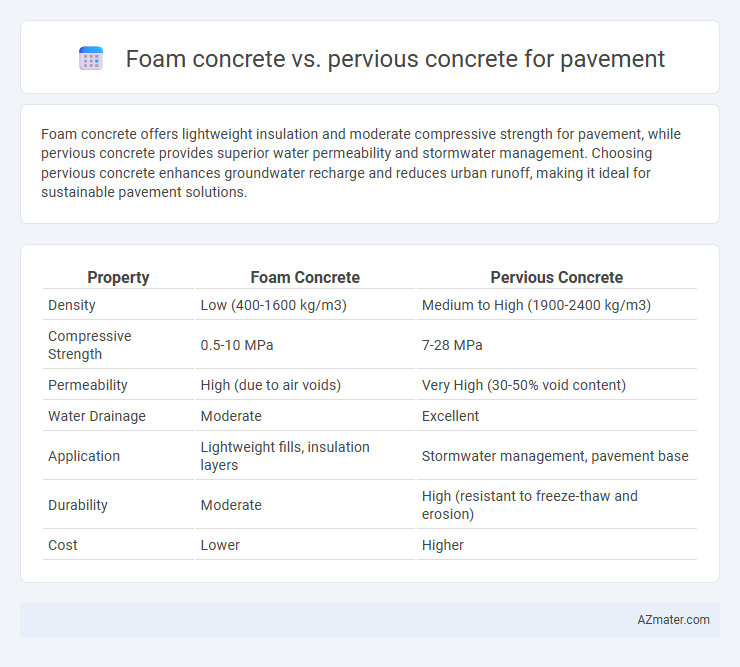Foam concrete offers lightweight insulation and moderate compressive strength for pavement, while pervious concrete provides superior water permeability and stormwater management. Choosing pervious concrete enhances groundwater recharge and reduces urban runoff, making it ideal for sustainable pavement solutions.
Table of Comparison
| Property | Foam Concrete | Pervious Concrete |
|---|---|---|
| Density | Low (400-1600 kg/m3) | Medium to High (1900-2400 kg/m3) |
| Compressive Strength | 0.5-10 MPa | 7-28 MPa |
| Permeability | High (due to air voids) | Very High (30-50% void content) |
| Water Drainage | Moderate | Excellent |
| Application | Lightweight fills, insulation layers | Stormwater management, pavement base |
| Durability | Moderate | High (resistant to freeze-thaw and erosion) |
| Cost | Lower | Higher |
Introduction to Foam Concrete and Pervious Concrete
Foam concrete is a lightweight, air-entrained concrete mixture with high thermal insulation and reduced density, making it ideal for applications requiring weight reduction and thermal efficiency. Pervious concrete consists of a porous structure that allows water to pass through, enhancing stormwater management and reducing runoff in pavement structures. Both materials offer distinct advantages for sustainable pavement design, with foam concrete emphasizing insulation and weight savings, while pervious concrete prioritizes permeability and water drainage.
Key Material Properties Compared
Foam concrete exhibits lower density and higher thermal insulation compared to pervious concrete, which offers superior permeability and drainage capabilities essential for pavement applications. The compressive strength of foam concrete typically ranges from 1 to 10 MPa, while pervious concrete achieves higher strengths, generally between 10 to 28 MPa, supporting heavy traffic loads. Pervious concrete's porosity of 15-25% enhances water flow, reducing runoff and improving stormwater management, whereas foam concrete's closed-cell structure limits permeability but provides excellent lightweight fill properties.
Structural Strength and Load-Bearing Capacity
Foam concrete exhibits lower structural strength and load-bearing capacity compared to pervious concrete due to its higher porosity and lightweight composition, making it less suitable for heavy traffic pavement applications. Pervious concrete offers superior load-bearing capacity and durability by efficiently distributing loads through its interconnected pore structure, allowing it to withstand vehicular stress and reduce pavement deformation. The compressive strength of pervious concrete typically ranges between 3,000 to 5,000 psi, whereas foam concrete often achieves only 500 to 1,500 psi, significantly impacting their respective performance in pavement structures.
Water Permeability and Drainage Performance
Foam concrete features low water permeability due to its closed-cell structure, making it unsuitable for applications demanding high drainage performance in pavements. Pervious concrete exhibits superior water permeability with interconnected voids, facilitating efficient stormwater infiltration and reducing surface runoff. The choice between foam concrete and pervious concrete hinges on drainage requirements, where pervious concrete outperforms foam concrete in enhancing pavement water management.
Thermal and Acoustic Insulation Differences
Foam concrete offers superior thermal insulation for pavement due to its lightweight, closed-cell structure that traps air and reduces heat transfer. In contrast, pervious concrete, with its porous interconnected voids designed for water permeability, provides limited thermal insulation but excels in sound absorption by disrupting and dissipating acoustic waves. The choice between foam and pervious concrete for pavement depends on prioritizing either enhanced temperature regulation or effective noise reduction based on specific project requirements.
Sustainability and Environmental Impact
Foam concrete offers superior sustainability benefits for pavement due to its lightweight composition, which reduces the demand for natural aggregates and lowers transportation emissions. Pervious concrete enhances environmental impact by promoting stormwater infiltration, mitigating urban runoff, and replenishing groundwater tables. Both materials contribute to green infrastructure, but foam concrete excels in energy efficiency and resource conservation, while pervious concrete prioritizes water management and reducing surface flooding.
Installation Process and Construction Techniques
Foam concrete for pavement requires mixing cement, water, fine aggregates, and pre-formed foam, which is then poured or pumped into place, offering lightweight and insulating properties with minimal compaction needs. Pervious concrete installation involves careful batching of coarse aggregates, cement, and minimal fines, followed by controlled placement using vibratory screeds to maintain permeability and prevent clogging. Both materials demand precise moisture control and curing conditions, with foam concrete emphasizing uniform foam distribution and pervious concrete focusing on maintaining an open-graded structure for effective water drainage.
Cost Analysis: Initial and Life-Cycle Expenses
Foam concrete generally offers lower initial costs due to its lightweight nature and simpler mixing process, reducing transportation and handling expenses for pavement construction. Pervious concrete, while often more expensive initially because of specialized materials and installation techniques, provides significant life-cycle savings through stormwater management benefits and reduced infrastructure requirements. Life-cycle expenses favor pervious concrete in urban settings where drainage and environmental compliance reduce maintenance and potential regulatory costs compared to foam concrete.
Ideal Applications and Use Cases in Pavement
Foam concrete is ideal for lightweight fill and insulation applications in pavement projects, offering excellent thermal properties and reducing the load on underlying soils. Pervious concrete is best suited for stormwater management in pavement surfaces, allowing water infiltration to reduce runoff and improve groundwater recharge. Both materials serve unique functions, with foam concrete enhancing structural support and pervious concrete optimizing drainage in pavement systems.
Choosing the Right Concrete for Pavement Needs
Foam concrete offers lightweight insulation and excellent thermal properties, making it ideal for pavement requiring low load-bearing capacity and enhanced drainage. Pervious concrete provides superior permeability, allowing water to pass through and reducing surface runoff, which is crucial for sustainable urban drainage systems. Selecting between foam and pervious concrete depends on specific pavement needs such as structural load, drainage requirements, and environmental impact goals.

Infographic: Foam concrete vs Pervious concrete for Pavement
 azmater.com
azmater.com